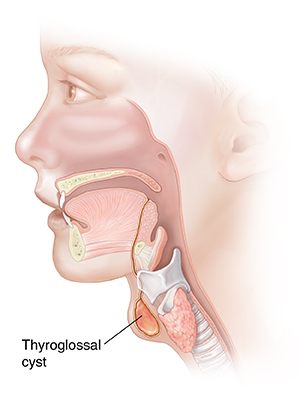A thyroglossal cyst is a type of neck lump (mass) that some people are born with. The thyroid gland is a butterfly-shaped gland in the lower front of your neck. During fetal development, thyroid cells have to move down a passage called the thyroglossal duct before reaching their final location in the neck. This duct should go away before birth. If the duct remains, it can fill with fluid and mucus. This is called a thyroglossal cyst.
Why thyroglossal cyst removal is done
The procedure is most often done to prevent infection of the cyst. If the cyst is infected, you may be given antibiotics. The cyst removal is done once the infection is resolved.. It may also be done if the cyst is large and causing symptoms. These can include problems breathing or swallowing.
How thyroglossal cyst removal is done
The procedure is done in a hospital or surgery center. It’s an outpatient procedure. This means you go home the same day. Have a family member or friend available to take you home. The time it takes to do the surgery can vary.
Before the procedure, you will be asked to sign an informed consent form. Signing the form means you know and understand the procedure's risks and benefits and that you agree to have it done. Be sure all your questions are answered before you sign.
During the procedure:
-
You lie on your back.
-
You are given anesthesia to allow you to comfortably sleep during the procedure.
-
The surgeon makes a cut (incision) in your neck to reach the cyst.
-
The surgeon removes the cyst. They also remove any remaining parts of the thyroglossal duct. If present, any sinus tracts are taken out. These are the abnormal pathways that connect the cyst to the surface of the skin. The surgeon may also remove abnormal thyroid tissue and part of the hyoid bone. This small bone is located in your neck near the thyroid.
-
When the surgery is done, the incision is closed with stitches (sutures) or special surgical glue that holds the skin together.
-
You are kept track of in the postanesthesia care unit as you awake from surgery and to make sure your blood pressure, breathing, and pulse are stable.
-
When you are awake and your vital signs are stable, you will be able to go home.
Risks of thyroglossal cyst removal
-
Failure to remove the entire cyst. This may mean you need more surgery.
-
General risks of surgery. This includes bleeding and infection.
-
Risks of anesthesia
Author: Yang, Sue
© 2000-2025 The StayWell Company, LLC. All rights reserved. This information is not intended as a substitute for professional medical care. Always follow your healthcare professional's instructions.

